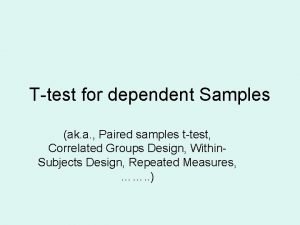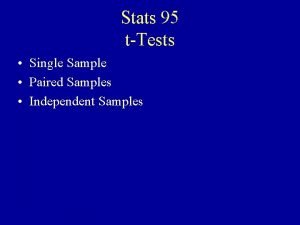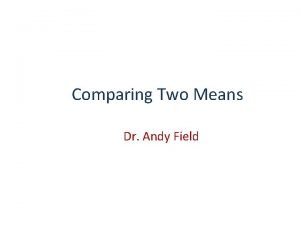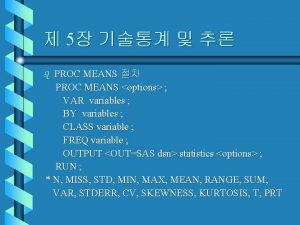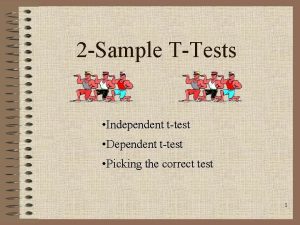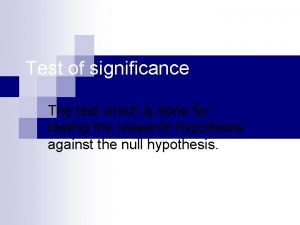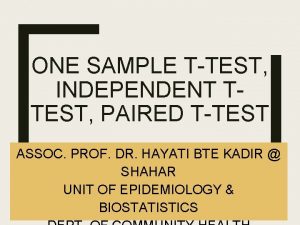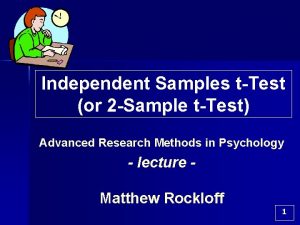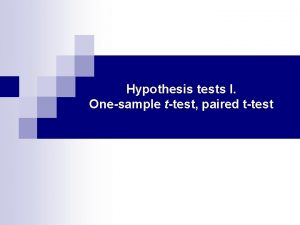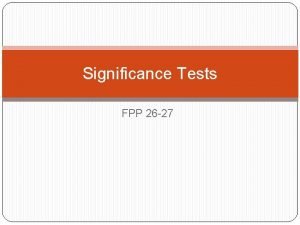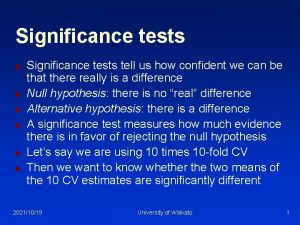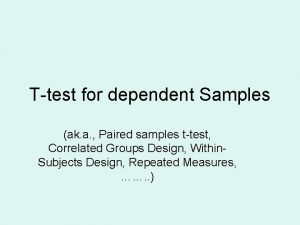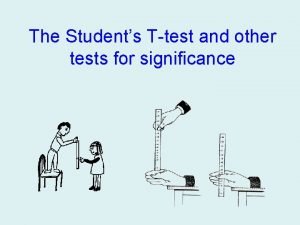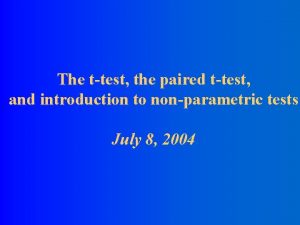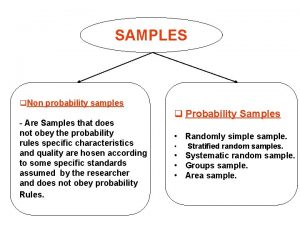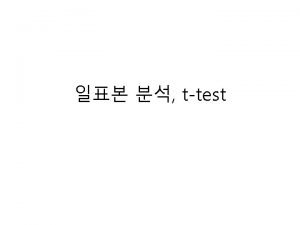SMALL SAMPLES tTEST INTRODUCTION The tests of significance

















- Slides: 17

SMALL SAMPLES t-TEST

INTRODUCTION Ø The tests of significance when samples are large we have used in Z – test ( ≥ 30). Ø If the sample size n is small (< 30), we have used in t-test. This distribution applicable to small samples was developed by W. S. Gosett (1908) who wrote under the pen name of “Student” has come to be known as students t- distribution.

ASSUMPTION Ø The parent population from which the sample is drawn is normal. Ø The sample observations are independent i. e. , the sample is random. Ø The population standard deviation is unknown.

APPLICATIONS If the sample mean differs significantly from the hypothetical value µ of the population mean Ø The significance of the difference between two sample means. Ø The significance of an observed sample correlation coefficient and sample regression coefficient. Ø The significance of observed partial correlation coefficient. Ø

METHODS OF t-TEST There are three methods of t-test v. Single mean v. Difference v. Paired of two means t-test

FORMULA FOR SINGLE MEAN where DOF: (n-1)

DIFFERENCE OF TWO MEANS where DOF:

PAIRED t - TEST Let us now consider the case when ü The sample sizes are equal, i. e. , n 1=n 2=n. ü The two samples are not independent but the sample observations are paired together. where DOF: (n-1)

INFERENCE v Calculated value greater than table value, H 0 is rejected at 5% and 1% level of the significance. v Calculated value less than table value, H 0 is accepted at 5% and 1% level of the significance.

EXAMPLE – 1 (SINGLE MEAN) The heights of 10 males of a given locality are found to be 70, 67, 62, 68, 61, 68, 70, 64, 66 inches. Is it reasonable to believe that the average height is greater than 64 inches? Test at 5% significance level, assuming that for 9 d. f. P(t > 1. 83) = 0. 05. Solution: H 0: µ = 64 inches H 1: µ ≠ 64 inches

C. V of t is 2. T. V of t for 9 df at 5% level of significance is 1. 833. Since the calculated value of t is greater than the table value of t, hence H 0 is rejected at 5% level of the significance and we conclude that the average height is greater than 60 inches.

EXAMPLE – 2 (DIFFERENCE OF TWO MEANS) Below are given the gain in weights of pigs fed on two diets A and B. Gain in weight Diet A: 25 Diet B: 44 32 34 30 34 24 22 10 47 14 31 32 40 24 30 30 32 31 35 35 18 25 21 35 29 22 Test if the two diets differ significantly as regards their effect on increase in weight. Solution: H 0: µ 1 = µ 2 inches i. e. , there is no significant between the mean increase in weight due to diets A and B. H 1: µ 1 ≠ µ 2 inches

here n 1 = 12, n 2 = 15

C. V of t is 0. 609. T. V of t for 25 df at 5% level of significance is 2. 06. Since the calculated value of t is less than the table value of t, hence H 0 is accepted at 5% level of the significance and we conclude that the two diets do not differ significantly as regards their effect on increase in weight.

EXAMPLE – 3 (PAIRED T - TEST) To verify whether a course in accounting improved performance, a similar test was given to 12 participated both before and after the course. The marks are: Before: After: 44 53 40 38 61 52 32 69 57 46 44 39 70 73 41 48 67 73 72 74 53 60 72 78 Was the course useful? Solution: H 0: There is no significant accounting performance before and after course H 1: There is significant accounting performance before and after course

here n = 12 C. V of t is 3. 47. T. V of t for 11 df at 5% level of significance is 2. 201. Since the calculated value of t is greater than the table value of t, hence H 0 is rejected at 5% level of the significance.

THANK YOU
 T test example
T test example Paired samples t-test formula
Paired samples t-test formula Effect size for t-test
Effect size for t-test Graphpad ttest
Graphpad ttest Varianzanalyse
Varianzanalyse Proc ttest
Proc ttest Ttest ind
Ttest ind Ace different tests iq tests still
Ace different tests iq tests still Test of significance
Test of significance Hát kết hợp bộ gõ cơ thể
Hát kết hợp bộ gõ cơ thể Frameset trong html5
Frameset trong html5 Bổ thể
Bổ thể Tỉ lệ cơ thể trẻ em
Tỉ lệ cơ thể trẻ em Gấu đi như thế nào
Gấu đi như thế nào Chụp phim tư thế worms-breton
Chụp phim tư thế worms-breton Alleluia hat len nguoi oi
Alleluia hat len nguoi oi Các môn thể thao bắt đầu bằng tiếng chạy
Các môn thể thao bắt đầu bằng tiếng chạy Thế nào là hệ số cao nhất
Thế nào là hệ số cao nhất
